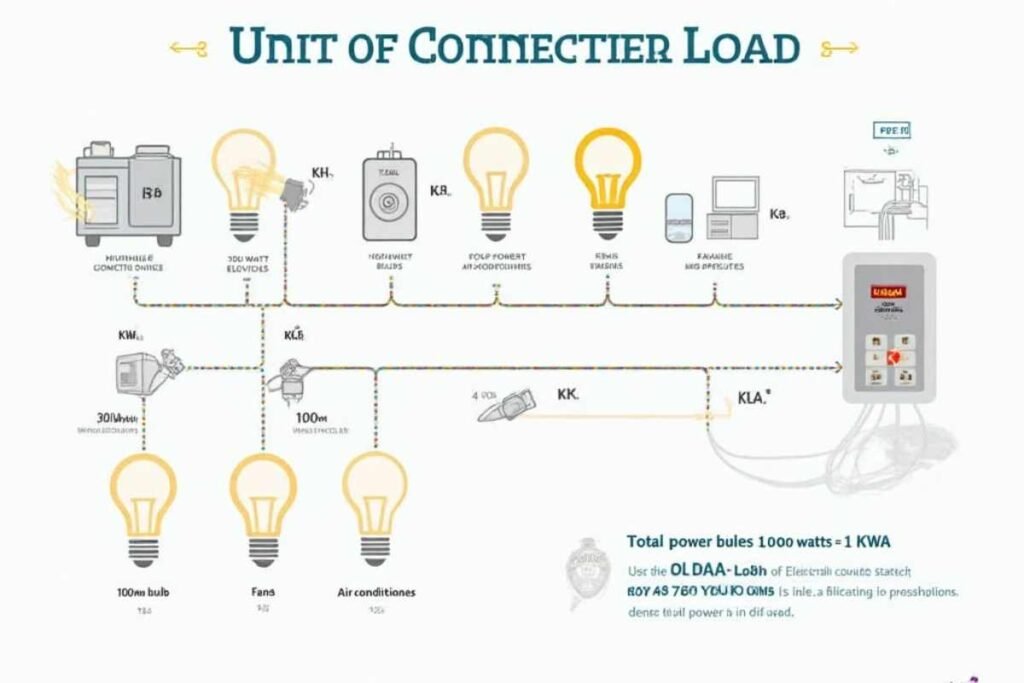The unit of connected load is one of the most essential concepts in electrical engineering and power distribution. Whether you’re an engineering student a professional electrician or someone trying to understand your electricity bill knowing the unit of connected load is crucial. It plays a significant role in power planning, energy distribution and designing efficient electrical systems.
In this comprehensive guide we’ll explain the meaning calculation importance and real life applications of connected load in detail. By the end you’ll understand how it affects electricity usage system capacity and overall energy management.
What is the Connected Load?

The unit of connected load is typically measured in kilowatts kW or kilovolt amperes kVA depending on the type of load and system requirements. Connected load refers to the total rated power of all electrical devices connected to a system or a circuit, regardless of whether they are running simultaneously or not.
For example if you have ten 100 watt bulbs connected to a circuit, your connected load for that circuit is 1,000 watts or 1 kW. Understanding this unit is vital because it forms the basis for designing wiring systems circuit breakers and distribution boards.
Understanding the Concept of Connected Load in Electrical Systems
The unit of connected load is a crucial term in electrical engineering that represents the total power capacity of all devices connected to a circuit. It includes lights, fans, air conditioners motors and other electrical appliances. Knowing this value helps engineers and consumers manage energy consumption efficiently and avoid system overloading.
Importance of Knowing the Unit of Connected Load
The unit of connected load is not just a theoretical concept it has practical importance in real-world applications. Power companies engineers and architects use this value for several purposes. Firstly it helps determine the required capacity of transformers and generators. Secondly it ensures that circuit breakers and wiring are capable of handling the expected load safely analysis-of-blockchain-innovations/.
Finally it assists in energy audits and billing calculations by understanding how much power is theoretically demanded by connected devices. Without knowing the correct unit of connected load you risk overloading electrical systems leading to inefficiency breakdowns or even hazards like short circuits and fires.
How Connected Load Affects Power Distribution?
The unit of connected load is directly related to how electricity is distributed across residential, commercial and industrial systems. Power supply companies design transformers feeders and circuits based on the total connected load. If the load exceeds planned limits it can lead to voltage drops power cuts or system failures making accurate load estimation essential solutions-digital-transformation/.
Step by Step Guide to Calculating Connected Load?
Accurately calculating the unit of connected load is critical for both residential and commercial electrical systems. Here’s a simple approach:
Identify All Electrical Devices
List all appliances lighting systems motors and other connected equipment.
Check the Rated Power
Each device has a nameplate or manual indicating its rated power in watts or kilowatts.
Convert to Common Units
Convert all ratings to a single unit, usually kW, for uniformity.
Add Up the Loads
Sum up the ratings of all devices to get the total connected load.
Apply Demand Factor
Not all devices run simultaneously, so apply a demand factor to estimate realistic power usage.
This calculated value ensures that your system can safely handle the expected load while avoiding unnecessary oversizing.
Real Life Applications of Connected Load
The unit of connected load is widely used across various sectors, from household energy management to large-scale industrial operations:
- In residential buildings it helps homeowners understand their total electricity demand and plan for efficient usage.
- In commercial complexes engineers rely on it to design wiring layouts and select appropriate protection systems.
- In industrial plants knowing the connected load prevents power fluctuations and unexpected shutdowns.
From government regulations to smart grid optimization connected load calculations influence decision-making at every level.
Formula for Calculating Connected Load

The unit of connected load is generally calculated using this formula:
Connected Load kW = Sum of Rated Power of All Devices in kW.
For example, if a household uses four 200-watt bulbs, two 1.5 kW air conditioners and a 1 kW geyser the connected load will be:
(4 × 0.2) + (2 × 1.5) + 1 = 5.3 kW.
Relationship Between Connected Load and Electricity Billing
Understanding how the unit of connected load is related to billing can help you manage energy costs effectively. Power distribution companies often calculate charges based on the total connected load for commercial and industrial consumers.
If your connected load exceeds a certain threshold, you may face higher tariffs, penalties or the need for additional approvals. Accurately declaring and optimizing your connected load ensures compliance with energy regulations and prevents unexpected costs.
Impact of Connected Load on Energy Efficiency
The unit of connected load is directly linked to energy efficiency in residential commercial and industrial settings. Oversized systems result in energy wastage while undersized systems cause power outages and safety issues.
Energy managers use connected load data to optimize:
- Proper equipment sizing
- Power distribution
- Preventive maintenance scheduling
- Sustainable energy practices
Accurate calculations promote cost savings reduced carbon footprints and improved operational efficiency.
Role of Connected Load in Electrical Safety
The unit of connected load is vital for ensuring safety in electrical installations. Overloading circuits without proper load calculation increases the risk of overheating, short circuits, and fire hazards. By knowing the connected load electricians can choose the right circuit breakers wiring sizes and distribution systems to maintain safety standards.
Connected Load in Smart Grids and IoT Systems

In the era of smart technologies the unit of connected load is becoming more significant than ever. Smart meters IoT enabled appliances and automated systems constantly communicate power requirements to optimize energy consumption.
These technologies allow real-time monitoring and adjustment of connected loads ensuring that power systems are neither underutilized nor overloaded. This is particularly vital for cities adopting smart grid solutions to meet growing energy demands efficiently software-development-practices/.
Conclusion
The unit of connected load is a foundational concept in understanding power distribution energy efficiency and safe electrical system design. Whether you’re calculating your home’s energy demand or planning a large scale industrial setup knowing your connected load helps you make informed decisions reduce costs and ensure safety.
With rapid advancements in smart technologies mastering connected load calculations is more important than ever for students engineers and energy professionals.
Looking for easy methods and advanced techniques to handle this? Click here and explore our detailed article with complete solutions!
Botbro Login: Access Smart Automation Securely
Epson L3210 resetter software download & fix guide
HQPotner: Smart Financial Software for Your Business
FAQs
What is the unit of connected load?
The unit of connected load is typically measured in kilowatts kW or kilovolt amperes depending on system specifications.
How do you calculate the connected load?
Add up the rated power of all connected devices in kilowatts and apply a demand factor to estimate realistic consumption.
Why is knowing the connected load important?
It ensures proper equipment sizing prevents overloads supports efficient energy management, and aids in accurate billing.
Is connected load the same as maximum demand?
No. Connected load is the total installed capacity, while maximum demand is the highest power actually drawn at any time.
How does connected load affect electricity bills?
Higher connected loads may lead to increased tariffs or penalties especially for commercial and industrial consumers.
Does connected load impact energy efficiency?
Yes. Accurate connected load management helps optimize system performance reduce wastage and improve energy efficiency.


